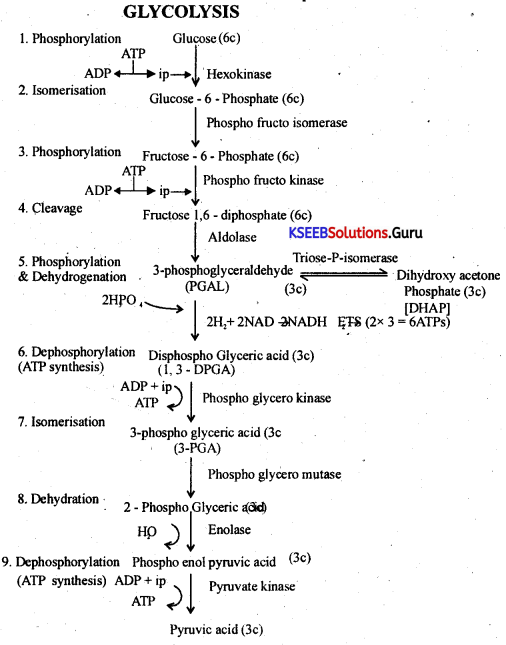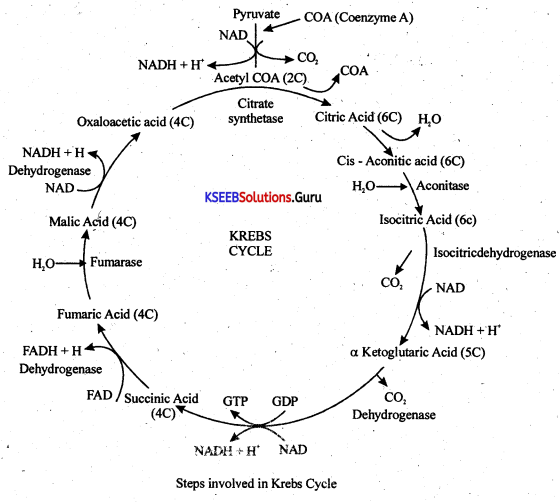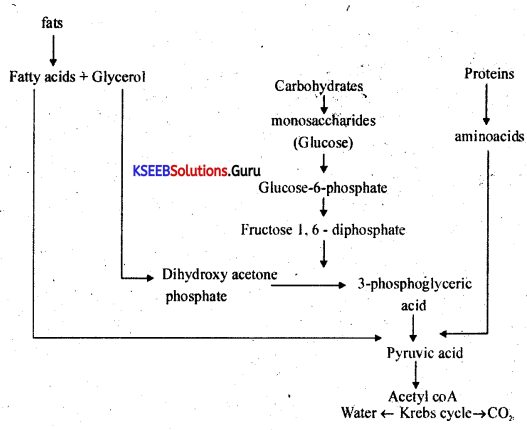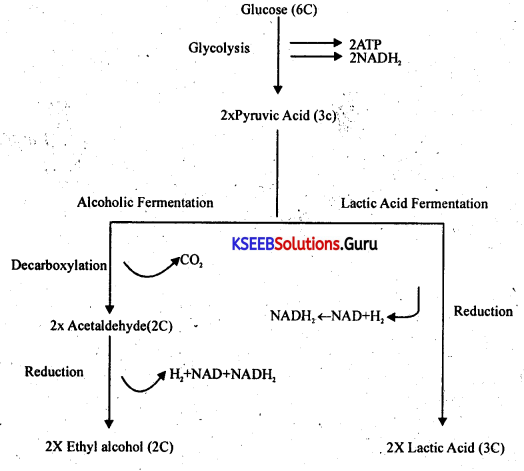Karnataka 1st PUC Biology Question Bank Chapter 14 Respiration in Plants
1st PUC Biology Respiration in Plants One Marks Questions and Answers
Question 1.
Name the site of glycolysis.
Answer:
Cytoplasm of the cell.
Question 2.
How many molecules of ATP are formed for every molecule of glucose during aerobic respiration?
Answer:
38 ATP molecules
![]()
Question 3.
What is the RQ value for carbohydrates?
Answer:
One.
Question 4.
What is the RQ value for organic acids?
Answer:
More than one.
Question 5.
Name the compound that reacts with Acetyl CoA to form Citric acid during Kreb’s cycle.
Answer:
Oxalo acetic acid.
Question 6.
What is Pasteur’s effect?
Answer:
Sudden change from anaerobic respiration to aerobic respiration due to the availability of oxygen in facultative anaerobes is called Pasteur’s effect.
![]()
Question 7.
Define Respiratory quotient.
Answer:
It is defined as the ratio of volume of CO2 liberated to the volume of oxygen utilised. Volume of CO, liberated

Question 8.
In which cell organelle Kreb’s cycle occurs?
Answer:
Mitochondria.
Question 9.
Name the phase which is common for both aerobic and anaerobic respiration?
Answer:
Glycolysis.
Question 10.
What are respiratory substrates? Name the most common respiratory substrate.
Answer:
Raw materials of cellular respiration which can yield ATT on break down are called respiratory substrates. e.g: Carbohydrates and proteins.
![]()
1st PUC Biology Respiration in Plants Two Marks Questions and Answers
Question 1.
Define aerobic cellular respiration?
Answer:
Aerobic respiration can be defined as a step wise complete oxidation of food molecules, into simple inorganic compounds, in the presence of molecular oxygen with the release of energy.
C6H12O6 + 6O2 → 6CO2 + 6H2O + 686 kcal. .
Question 2.
What is fermentation? Give the equation for alcoholic fermentation.
Answer:
It can be defined as a process of incomplete breaking down of food molecules into Ethyl alcohol, C02 and lactic acid by the activity of micro organisms or enzymes in the absence of molecular oxygen.
Equation for alcoholic fermentation is
![]()
Question 3.
Define respiratory quotient. Give the RQ value of carbohydrates.
Answer:

RQ value for carbohydrates is one.
Question 4.
Define RQ. What is its value for fats?
Answer:
Respiratory quotient (R-Q)
Respiratory quotient can be defined as the ratio of volume of CO2 released, to O2 consumed
to break one molecule of respiratory substrate completely.
\(\mathrm{RQ}=\frac{\text { Volume of } \mathrm{CO}_{2} \text { released }}{\text { Volume of } \mathrm{O}_{2} \text { consumed }}\)
R.Q of carbohydrate is 1.
RQ of proteins is 0.7
RQ of fats is 0.71
RQ of organic acid is more than 1(1.2 or 1.3).
![]()
Question 5.
What is oxidative phosphorylation?
Answer:
Oxidative phosphorylation or electron transport-linked phosphorylation or terminal oxidation is the metabolic pathway in which cells use enzymes to oxidize nutrients, thereby releasing the chemical energy stored within the nutrients in order to produce adenosine triphosphate.
Question 7.
Differentiate aerobic cellular respiration from anaerobic ceUular respiration.
Answer:
| Aerobic C.R | Anaerobic C.R |
| 1. Occurs in the presence of molecular oxygen. | 1. Occurs in the absence of oxygen. |
| 2. Centered in mitochondria and cytoplasm, | 2. Centered in cytoplasm. |
| 3. Glucose is completely oxidised into CO2 and H2O. | 3. Glucose is incompletely oxidised into C2H5OH and CO2. |
| 4. Generates 38 ATPs per glucose. | 4. Generates only 2 ATPs per glucose. |
| 5. Occurs in a great majority of organisms called anaerobes. | 5. Occurs in only a few of organisms called aerobes. |
1st PUC Biology Respiration in Plants Five Marks Questions and Answers
Question 1.
Give the schematic representation of glycolysis?
Answer:
It occurs in cytoplasm of the cell.
It is an enzymatic reaction, thus temperature sensitive.
It is a common reaction for both aerobic and anaerobic respiration.

Question 2.
What are the main steps in aerobic respiration? Where does it take place?
Answer:
Aerobic respiration: It is a completely oxygen dependent process, and occurs in the presence of molecular oxygen. It is centered in mitochondria. Here glucose is completely oxidised into CO2 and water. It generates 38 ATP per glucose, and hence more efficient energy releasing process. It occurs in the majorily of living organisms called aerobes.
C6 H12 O6+ 6O2 → 6CO2 + 6H2O+ 686kcal + 38ATP mol
![]()
Question 3.
Give the schematic representation of an overall view of Krebs cycle.
Answer:

Note: To account for two molecules of acetyl CoA produced from 1 molecule of glucose the entire reaction has to be multiplied by two.
Bioenergetics:
1. Number of ATPs produced = 2
2. Number of NADH2 produced = 6 (6*3=18ATPs)
3. Number ofFADH2 produced = 2 (2*2=4 ATPs)
The total yield of ATPs = 24
Note:- Efficiency of Krebs cycle along with its predatory reaction is 30 ATPs.
![]()
Question 4.
Explain ETS.
Answer:
It occurs on the inner mitochondrial membrane, using electron acceptor molecules. In this step the products of glycolysis and kreb’s cycle i.e.. NADH2, and FADH2 pass along the electron transport chain of mitochondria. The energy held by their hydrogen atoms is released, and utilised in the synthesis of ATPs. This includes two processes.
- Oxidation of NADH2 and FADH2 (i.e., removal of hydrogen).
- Addition of phosphate to ADP to form ATP. Hence these processes are together known as oxidative phosphorylation.
The electron carriers, Flavin mononucleotide, ubiquinone, cytochromes (cyt b6, cyt c, cyt a, cyt a3) are found on the surface of cristae. As the electrons flow along the chain, the carriers get alternately oxidised and then reduced. Hence these reactions are called redox reactions. Finally hydrogen atoms are given to molecular oxygen to form H2O which is the by product. Continuous supply of oxygen is required to carry this out.
The energy released during electron flow is used in the synthesis of ATPs from ADPs, with the addition of inorganic phosphate.
- Thus both oxidation and phosphorylation occur simultaneously.
- During the oxidation of NADH2, three molecules of ATPs are synthesised, and during oxidation of FADH2 two ATPs are synthesised.
Question 5.
Discuss ‘The respiratory pathway is an amphibolic pathway.”
Answer:
Since respiration involves break down of organic compounds, it has been considered as a catabolic process, and the respiratory pathway as a catabolic process. But as different substances enter the pathway as respiratory substrates, and certain intermediate of the respiratory pathway are also vithdrawn for synthesis of other compounds.
For e.g: Fatty acids would be broken down into acetyl CoA for entering the pathway, acetyl C,A from the respiratory pathway will be taken out if fatty acids have to be synthesised. Similarly the respiratory pathway, intermediates are involved in the synthesis of proteins, because respiratory pathway involves both anabolism and catabolism it is called as an amphibolic pathway.

![]()
Question 6.
Give the schematic representation of glycolysis:
Answer:
It occurs in cytoplasm of the cell.
It is an enzymatic reaction, thus temperature sensitive.
It is a common reaction for both aerobic and anaerobic respiration.

![]()
Question 7.
Give the schematic representation of Kreb’s cycle with its preparatory reaction?
Answer:

Note: To account for two molecules of acetyl CoA produced from 1 molecule of glucose the entire reaction has to be multiplied by two.
Bioenergetics:
1. Number of ATPs produced = 2
2. Number of NADH2 produced = 6 (6*3=18ATPs)
3. Number ofFADH2 produced = 2 (2*2=4 ATPs)
The total yield of ATPs = 24
Note:- Efficiency of Krebs cycle along with its predatory reaction is 30 ATPs.
![]()
Question 8.
Describe the mechanism of fermentation in the presence of yeast and lactic acid bacteria?
Answer:
The first step of anaerobic respiration is glycolysis, in which glucose is incompletely oxidised to 2 pyruvic acid molecules with 2 ATP and 2NADH2 formed as by-products.
Pyruvic acid formed is used for alcoholic fermentation or lactic acid fermentation. In alcoholic fermentation, the pyruvic acid is first decarboxylated to acetaldehyde liberating CO2. Later acetaldehyde is reduced to ethyl alcohol by NADH2 of glycolysis. This process occurs in anaerobes like yeast and bacteria.
In lactic acid fermentation, the pyruvic acid is directly reduced to lactic acid by NADH2 of glycolysis. NO CO2 is liberated. It occurs in lacto bacilli, and skeletal muscles.

1st PUC Biology Respiration in Plants Text Book Questions and Answers
- Respiration is an essentially an intracellular oxidative catabolic process in which, the potential energy of food molecules is converted into kinetic energy namely ATP, along with heat energy as a by product.
Based on whether the process uses oxygen or not, it is of two types namely,
- Aerobic respiration.
- Anaerobic respiration.
Aerobic respiration: It is a completely oxygen dependent process, and occurs in the presence of molecular oxygen. It is centered in mitochondria. Here glucose is completely oxidised into CO2 and water. It generates 38 ATP per glucose, and hence more efficient energy releasing process. It occurs in the majority of living organisms called
C6 H12O6+ 6O2 → 6CO2 + 6H2O+ 686kcal + 38ATP mol
Anaerobic respiration: It is an oxygen independent process and occurs in the absdmoli oxygen. It is centered in general cytoplasm. Here glucose is incompletely oxidised into ethyl alcohol, and CO2 or lactic acid generates only 2 ATPs per glucose molecule, and hence less efficient energy releasing process. It occurs only in a few organisms like bacteria, yeast etc.
![]()
Mechanism of aerobic respiration: ‘
Stepwise breakdown of respiratory substances to CO2 and H2O in presence of O2 is referred to as aerobic respiration. This involves the following four steps:
- Oxidative decarboxylation.
- Krebs cycle / TCA cycle / Citric acid cycle.
- Electron transport system / Terminal oxidation / Oxidative phosphorylation.
1. Glycolysis:
- It is the stepwise breakdown of glucose into 3 carbon (CH3COCOOH) pyruvic acid with the production of NADH2, and ATP. It occurs in the cytoplasm of the cell. It does not require the oxygen.
- It is a common step for both aerobic, and anaerobic cellular respiration.
Steps:
- Glucose is phosphorylated by 1 ATP to form glucose 6 phosphate catalysed by hexokinase.
- Glucose 6 phosphate is isomerised to fructose 6 phosphate, catalysed by isomerase.
- Fructose -6- phosphate is phosphorylated by another ATP to form fructose 1,6 diphosphate, catalysed by phosphoffucto kinase.
- Fructose 1,6 diphosphate cleaves to form 2 molecules of 3- phosphoglyceraldehyde which isomerize into dihydroxy acetone phosphate by a reversible reaction.
- The two molecules of triose phosphates undergo phosphorylation followed by dehydrogenation to form two molecules of 1,3 Diphosphoglyceric acid, and catalysed by PGAL dehydrogenase, more NADH2 is formed.
- The two molecules 1,3 DPGA get dephosphorylated, to form two molecules of catalysed by DPGA kinase, here 2 ATP are formed.
- The two molecules 1,3 PGA are rearranged to form two molecules of 2 PGA, catalysed by mutase.
- The two molecules of 2PGA are enolated (dehydrated) to form, two molecules of phosphopyruvate, catalysed by enolase.
- The two not of PEP are dephosphorylated to form two molecules of Pyruvate, and catalysed by PEP kinase. Here 2 ATPS are generated.
![]()
2. Oxidative Decarboxylation:
This step is a connecting link between glycolysis, and Krebs cycle. Here pyruvic acid is decarboxylated to acetyl CoA, TPP, NAD, Mg+2, lipoic and the enzyme needed is pyruvate decarboxylase and dehydrogenase. NADH2 is formed by the reduction of NAD.
3. Kreb’s Cycle:
Acetyl CoA produced in oxidative decarboxylation enters into the matrix of mitochondria and participates in Kreb’s cycle.
1. The acetyl CoA combines with oxalo acetic to form citric acid in the presence of citrate synthetase. The first stable carbon compound is citric acid, hence it is also called as citric acid cycle.
2. Citric acid gets converted into Cis aconitic acid by losing a water molecule. It is then hydrated to form isocitric acid. These two reactions are brought about by aconitase enzyme.
3. Isocitric acid gets dehydrogenated to form oxalo succinic acid in the presence of dehydrogenase. The liberated hydrogen is accepted by NAD, and gets reduced NADH2.
4. Oxalosuccinic acid gets decarboxylated to a-keto glutaric acid in the presence of , decarboxylase enzyme. Here one CO2 molecule is produced.
5. a-keto glutaric acid combines with coenzyme to form succinyl CoA in the presence of decarboxylase enzyme. During this, NAD is reduced to NADH2 and a molecule CO2 is also liberated.
6. Succinyl CoA loses CoA in the presence of succinyl thiokinase, to form succinic and during this conversion, a small amount of energy is liberated and is utilised for the formation of GTP.
7. Succinic acid gets dehydrogenated to form fiimaric acid in the presence of dehydrogenase.Here FAD gets reduced to FADH2
8. Fumaric acid gets hydrated to form malic acid in the presence of fumerase enzyme.
![]()
9. Malic acid is then dehydrogenated into oxaloacetic acid in the presence of dehydrogenase. Here NAD is reduced to NADH2 . This oxalo acetic acid again enters into Krebs cycle, and gets reused in the process.
For the complete oxidation of one glucose, Kreb’s cycle takes place twice.
4. Electron Transport Chain/ Terminal Oxidation / Phosphorylation:
It occurs on the inner mitochondrial membrane, using electron acceptor molecules. In this step the products of glycolysis and kreb’s cycle i.e.. NADH2, and FADH2 pass along the electron transport chain of mitochondria. The energy held by their hydrogen atoms is released, and utilised in the synthesis of ATPs. This includes two processes.
- Oxidation of NADH2 and FADH2 (i.e., removal of hydrogen).
- Addition of phosphate to ADP to form ATP. Hence these processes are together known as oxidative phosphorylation.
The electron carriers, Flavin mononucleotide, ubiquinone, cytochromes (cyt b6, cyt c, cyt a, cyt a3) are found on the surface of cristae. As the electrons flow along the chain, the carriers get alternately oxidised and then reduced. Hence these reactions are called redox reactions. Finally hydrogen atoms are given to molecular oxygen to form H2O which is the by product. Continuous supply of oxygen is required to carry this out.
The energy released during electron flow is used in the synthesis of ATPs from ADPs, with the addition of inorganic phosphate.
![]()
- Thus both oxidation and phosphorylation occur simultaneously.
- During the oxidation of NADH2, three molecules of ATPs are synthesised, and during oxidation of FADH2 two ATPs are synthesised.
Mechanism of Anaerobic Cellular Respiration:
- Respiration in which free oxygen is not used is called anaerobic respiration.
- Obligate anaerobes like yeast, and some bacteria undertake anaerobic cellular respiration.
Lactic and fermentation:
In the absence of oxygen, pyruvic acid obtained from glycolysis is converted to lactic acid. e.g: muscular contraction in animals. This is called lactic acid fermentation.
Alcoholic fermentation:
In the absence of oxygen, pyruvic acid obtained from glycolysis is converted to ethanol in lower plants like yeasts. This is alcoholic fermentation.
External factors affecting respiration:-
1. Temperature: Optimum temperature for respiration is 18-30°C. Rate of respiration falls at very low temperatures and above 40°C. This effect of temperature is based on its effect on enzymes.
2. Oxygen: Increase in oxygen concentration increases the rate of aerobic cellular respiration. If the concentration of O2 is less than 1% then the cells switch over to anaerobic respiration for a temporary period.
3. CO2: Increase in internal CO2 concentration lowers the rate of respiration.
4. Light: Intensity of light affects stomatal movements, and thus indirectly affects the rate of respiration.
5. Water : Water is essential for enzyme activity and hydrolysis of substrate.
6. Respiratory inhibitors: Chemicals which inhibit respiration are called respiratory substrates.
e.g: Mercuric chloride, Iodoacetate etc.
![]()
Respiratory quotient (R-Q)
Respiratory quotient can be defined as the ratio of volume of CO2 released, to O2 consumed to break one molecule of respiratory substrate completely.
\(\mathrm{RQ}=\frac{\text { Volume of } \mathrm{CO}_{2} \text { released }}{\text { Volume of } \mathrm{O}_{2} \text { consumed }}\)
Volume of O2 consumed
RQ of carbohydrate is 1,
RQ of proteins is 0.7 RQ of fats is 0.71
RQ of organic acid js more than 1 (1.2 or 1.3).
Pasteur’s effect:
Facultative anaerobes like yeast of anaerobic bacteria, shift from anaerobic cellular respiration to aerobic cellular respiration upon oxygen availability. This is called Pasteur’s effect RESPIRATORY PATHWAY – An Amphibolic pathway:
Since respiration involves break down of organic compounds, it has been considered as a catabolic process, and the respiratory pathway as a catabolic process. But as different substances enter the pathway as respiratory substrates, and certain intermediate of the respiratory pathway are also withdrawn for synthesis of other compounds.
For e.g: Fatty acids would be broken down into acetyl COA for entering the pathway, acetyl COA from the respiratory pathway will be taken out if fatty acids have to be synthesised.
![]()
- Similarly the respiratory pathway, intermediates are involved in the synthesis of proteins, because respiratory pathway involves both anabolism and catabolism it is called as an amphibolic pathway.
